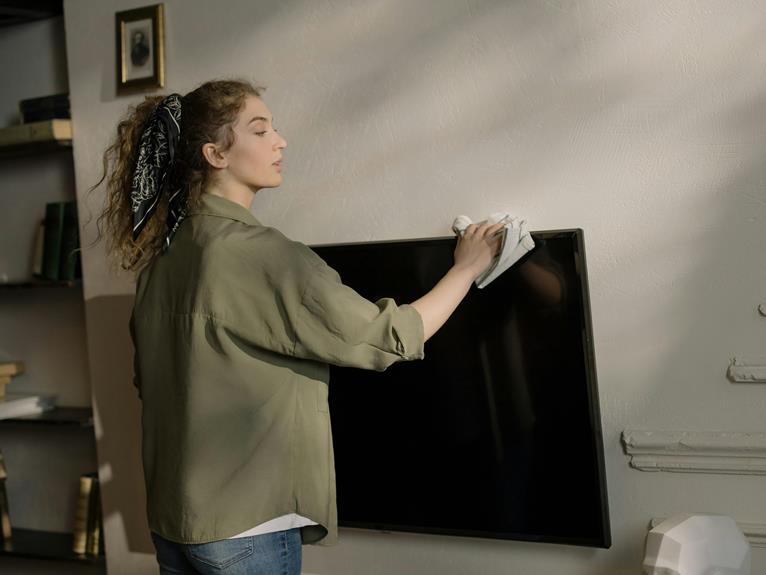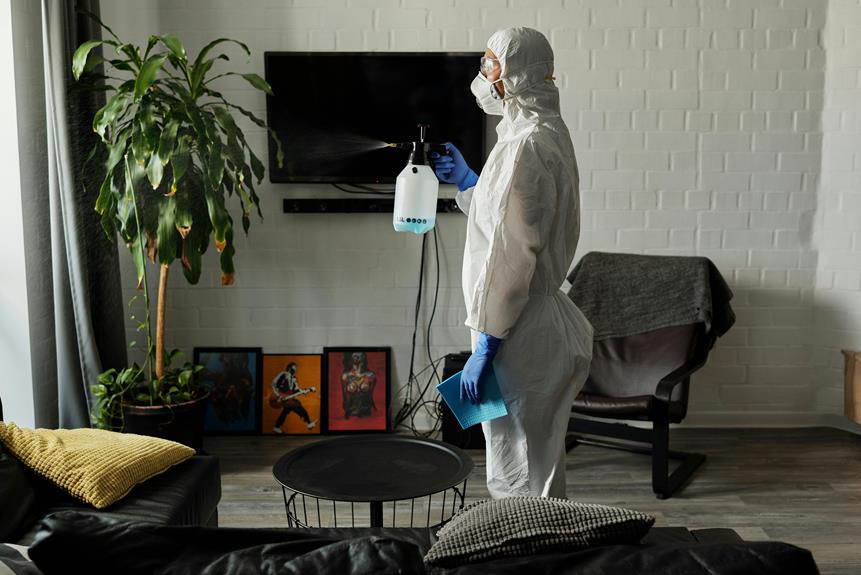Let’s find out how to Clean a TV Screen? First, unplug your TV to minimise electrical hazards. Use a microfiber cloth to gently remove dust and dry dirt. Avoid circular motions to prevent micro-abrasions.
For a deeper clean, apply a screen-specific cleaner to the cloth, not directly on the screen. Wipe in linear motions and use a bit more cleaner for stubborn spots.
Make certain the screen is completely air-dried before plugging the TV back in. Continue with these steps for thorough cleaning techniques and maintenance tips.
Key Information
- Always unplug the TV before cleaning to ensure safety and prevent damage.
- Use a microfiber cloth and a screen-friendly cleaner designed for electronics.
- Gently remove dust with a dry cloth, applying minimal pressure in a linear motion.
- Apply the cleaner to the cloth, not directly on the screen, and wipe in circular motions.
- For stubborn spots, use more cleaner on the cloth and wipe gently, allowing the screen to air dry completely.
Preparation
Before cleaning your TV screen, make sure you have a microfiber cloth and a screen-friendly cleaner ready.
These tools are important for safely and effectively removing dirt and dust. Make sure the cleaner is specifically designed for electronic screens to avoid potential damage.
First, you’ll need to use a dry microfiber cloth to gently wipe away any dust and dry dirt. This step is vital for preventing scratches.
Unplug the TV
To guarantee your safety, always unplug the TV before starting the cleaning process. Do not leave the TV on standby. Disconnecting the power source minimises the risk of electric shock when handling the delicate screen surface.
Locate the power cord, typically found at the back of the TV, and firmly pull the plug from the outlet.
This simple step prevents any potential damage to the screen or internal components due to static electricity or inadvertent button presses.
Unplugging the TV is an essential safety measure endorsed by manufacturers and experts.
It ensures that your cleaning procedure won’t interfere with the electronic circuits, safeguarding both you and the device.
Dry Dusting
When dry dusting, gently use a dry microfiber cloth to remove dust and dry dirt from your TV screen to prevent scratches and streaks.
Make sure you apply minimal pressure, moving the cloth in a consistent, linear motion. Avoid circular motions to reduce the risk of micro-abrasions.
Never use abrasive materials or paper towels, as they can damage the screen’s delicate surface.
Pay particular attention to the entire screen, including corners and edges, where dust tends to accumulate.
Regularly dry dusting your TV screen can greatly enhance its longevity and maintain excellent visual clarity.
Always handle the screen with care, prioritising safety and avoiding any aggressive actions that might compromise the screen’s integrity.
Applying a Cleaner
Begin by choosing a screen cleaner specifically formulated for TV screens to make sure you don’t damage the delicate surface.
Apply the cleaner to a microfiber cloth, not directly onto the TV screen, to prevent liquid from seeping into the device.
Use a moderate amount of cleaner to avoid streaking or potential damage. Gently wipe the screen in a consistent, circular motion. It’s essential to prevent oversaturation; a damp cloth suffices.
Allow the screen to air dry completely before turning the TV back on, ensuring no moisture remains. This method maintains the integrity of your TV screen while ensuring it’s thoroughly cleaned.
Always adhere to manufacturer guidelines for the best safety and performance.
Targeting Stubborn Spots
If you encounter stubborn spots, apply a bit more screen cleaner to your microfiber cloth and gently wipe in circular motions to lift the grime.
Maintain consistent, gentle pressure to avoid damaging the display. Don’t use excessive force, as it can lead to scratches or pixel damage.
For particularly resilient stains, repeat the cleaning process as necessary. Make sure the cloth is only slightly damp and not overly saturated to prevent moisture from seeping into the screen’s edges.
Always prioritise using a microfiber cloth, as other materials might cause abrasions.
After addressing the stubborn spots, allow the screen to air dry completely to prevent streaking or residue. Repeat these steps until the screen is spotless and clear.
Drying Process
After tackling stubborn spots, let your TV screen air dry completely to avoid streaks and watermarks.
This step is important; turning the TV on before the screen is dry can cause potential damage.
Avoid using a cloth to dry the screen, as it can leave behind lint or fibers, compromising the screen’s clarity. Patience is vital here—make sure the screen is fully dry before proceeding.
Proper drying maintains the quality and longevity of your TV. Keep the room well-ventilated to expedite the drying process.
By taking your time, you guarantee a clean, streak-free finish, preserving your TV’s performance and visual appeal.
Frequently Asked Questions
What Is the Best Way to Clean a Flat Screen TV?
Turn off the TV. Use a microfiber cloth with screen-friendly cleaner. Never spray directly onto the screen. Wipe gently in circular motions. Focus on stubborn spots. Let it air dry completely. Regular cleaning prevents damage and extends lifespan.
What Is the Best Solution to Clean a TV Screen With?
Use a mixture of equal parts distilled water and white vinegar. Avoid harsh chemicals like ammonia or alcohol. Apply the solution to a microfiber cloth, not directly to the screen. Wipe gently, then dry with another microfiber cloth.
Can I Use a Damp Cloth to Clean My Flat Screen TV?
No, don’t use a damp cloth; moisture can seep into components, causing permanent damage. Instead, use a dry microfiber cloth or a screen-friendly cleaner. Always adhere to the manufacturer’s guidelines to guarantee your TV’s safety and warranty.
How Do I Get Fingerprints off of a Flat Screen TV?
To remove fingerprints from your flat screen TV, gently wipe with a microfiber cloth in a circular motion. Don’t apply excessive pressure or use harsh chemicals. For best results, use a cleaner specifically designed for electronics.
Conclusion
To finalise, make sure your TV is unplugged before cleaning. Dust gently with a microfiber cloth, then apply a safe screen cleaner sparingly.
For stubborn spots, use a slightly dampened cloth, avoiding excess moisture. Finally, dry the screen thoroughly to prevent streaks or damage.
Remember, safety and precision are paramount. By following these steps, you’ll maintain your TV’s clarity and longevity while protecting it from potential harm.
Enjoy your spotless screen!



